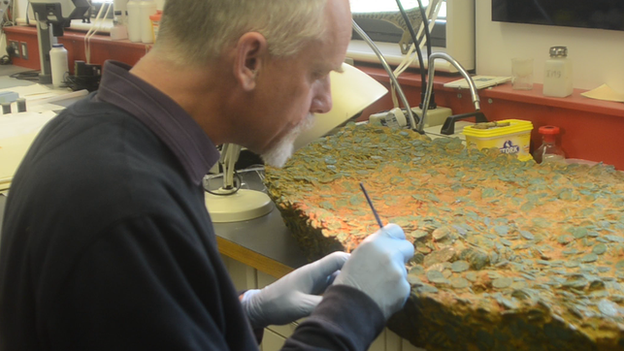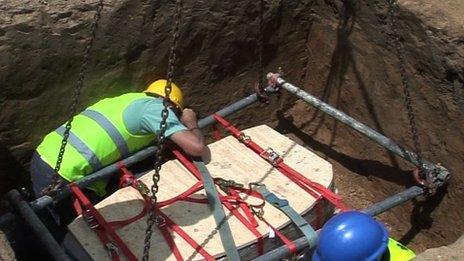Jersey hoard is 'world's largest' Celtic coin discovery
- Published

Neil Mahrer has made a replica of the coin hoard using silicon sheets to create a mould
A hoard of coins discovered in Jersey one year ago is the "largest in the Celtic world", according to an expert on the island.
Jersey Heritage Trust Conservator Neil Maher has spent the past year creating a model of the one tonne mound of silver and copper coins, gold pieces and mud.
He said: "This is the world's biggest Celtic coin hoard ever, this was a significant part of a tribe's wealth.
"It is also one of the world's biggest coin hoards and certainly the biggest coin hoard found in Britain."
Work to separate and uncover the secrets of the hoard has been delayed while Mr Mahrer works on other projects and details are agreed over long term conservation plans.

Archaeologists removed about two tonnes of earth containing about a tonne of coins
A large mound containing about 70,000 coins was discovered last year by two metal detector enthusiasts.
Reg Mead and Richard Miles began their hunt after a woman told them her father had found coins in a field some years before.
After the initial work looking at the surface of the mound taken from the ground in Jersey, Mr Mahrer started the process of replicating the object.
He said: "You mix silicon rubbers up, pour them on to the hoard and it will set on there. It then records in fine details so you can use copies for microscopic work.
"It was quit scary as I told people it would be fine, there would be no damage. I had used the technique on smaller things so was really pleased it worked out well."
When decisions are made over who has responsibility for conservation, Mr Mahrer said the work would begin to separate and catalogue every item contained in the hoard.
Neil Mahrer who made the replica of a coin hoard said removing the mould was "scary"
"Because we knew the process we want to do on the real hoard involves taking apart coin by coin by coin, we knew we would lose the original appearance.
"We thought that was important because, not only is it a pretty thing, but there might be important information in its size and shape in the future," he said.
The process of making a replica revealed a number of surprises according to Mr Mahrer.
He said: "It was a bit of a bonus if slightly embarrassing, one small part of the side collapsed more than I hoped and we lost two or three coins from a small area on one side.
"Completely by chance in there we found a small gold coin and it is the first gold one we have found.
"There are about 70,000 coins in the hoard but all the ones we have found so far are a mixture of silver and copper.
"Of the ones which fell out one was a small thick gold one which is about 100 years older than the rest of the coins."
He said they had uncovered about 1% of the coins so far and five gold items had been uncovered.

The gold coin is thought to be from the same tribe but about 100 years older than the others
"As this one about three or four coin depths fell out it leads to the question 'what else is in there'. We have only scraped the surface and we have already found five gold objects," he said.
Mr Mahrer said if they continued finding gold on that ratio, it could push up the value of the hoard.
"One gold coin on its own wouldn't add much to the value, a few hundred pounds, but if we get in and find more then who knows?"
He added: "We deliberately haven't removed any coins from the hoard yet, we are still waiting for various permissions over who owns the hoard and funding before we take it apart."
The value of the hoard was estimated at up to £10m when it was first removed from the ground.
Work is now under way to prepare the coins already uncovered, and the replica made by Mr Mahrer, for an exhibition at Jersey Museum next year.
The last time it went on display in 2012 the number of visitors to the museum trebled.
- Published16 December 2012
- Published17 September 2012
- Published13 September 2012
- Published13 September 2012
- Published26 June 2012